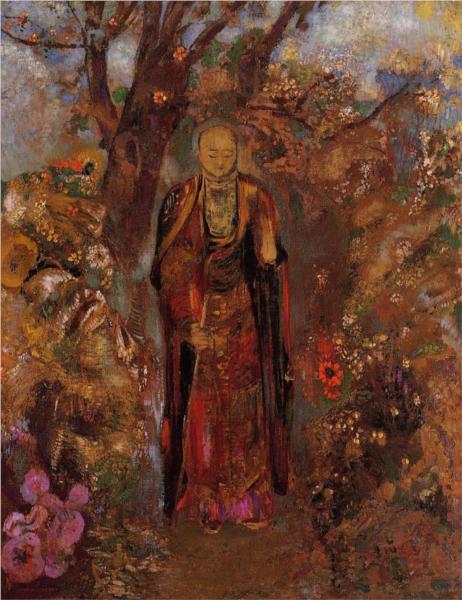
The intellectual component of the sacred anchor is direction: the rules by which we live. Many people omit this from their conception of the sacred or religious life, mentioning only meaning and purpose but I propose that the intellectual component, direction, is essential. It may not be as satisfying emotionally as the other elements, which probably explains why many people overlook or ignore it. Yet without it, we cannot use reason, much less wisdom, to chart an intelligent course that is likely to produce a good and productive life. We may know what we wish to accomplish (meaning) but we will not know, or will not follow, the proper steps to achieve our ends. The exclusion of direction from the holy Trinity may be as much, or more, a product of choice as of oversight.
In the Christian Trinity, the analog to direction is the Word, or Father; the analog to meaning is the Spirit, represented by the invisible feminine principle (unfortunately, the mother is absent, replaced by a formless “Holy Spirit”); the analog to purpose is the Son, the product of the parents, the Word made flesh and expressed as action. Perhaps this is why the Christian narrative is so enduring: it reaches deep into the psyche, straight to the mother lode of meaning, through a metaphor that brilliantly reflects a robust approach to life.
The reader may have surmised long ago that I had a Christian upbringing. Roman Catholics in particular may have grinned with memories of recognition. No doubt, my early life experiences have influenced this model, as they influenced J. Calvin (John Calvin) Chatlos, my mentor in this model, who grew up the son of a Christian minister. I do not propose that this model is the only one but considering especially that it has its genesis in someone else’s work, I feel at some liberty to say that I have not seen anything better, or as complete, as solid and as good. There may be other methods of spiritual and religious practice that will be more successful for some people, perhaps for most people but to my eye, this one offers the most complete and inclusive explanation of religious and spiritual life.
Real
True Narratives
Technical and Analytical Readings
Photographs
Documentary and Educational Films
Imaginary
Fictional Narratives
Poetry
Poems:
- Robert Frost, “The Death of the Hired Man” (analysis)
- Edgar Lee Masters, “George Gray”
- John Keats, “Lines Written in the Highlands After a Visit to Burns’ Country”
- Wallace Stevens, “Table Talk”
From the dark side:
- Edgar Lee Masters, “Hildrup Tubbs”
Music: Composers, artists, and major works
Johannes Brahms, Violin Concerto in D major, Op. 77 (1878) (approx. 36-46’), is a virtuoso work that takes a more calculated tone than the other great violin concerti. “. . . Brahms was serious, no doubt about it. His Violin Concerto might display a lyricism that sounds spontaneous, but this composer sweated over every bar.” “The fact that this violin concerto was written for a most famed and virtuoso violinist of that time suggests its difficulty. The concerto requires tremendous technique from the violinist performing the work.” “As the conductor and scholar Leon Botstein notes: ‘[Brahms] wanted to find a way to reconcile the most serious aspirations of instrumental music with the visceral power associated with the display of virtuoso technique.'” “Brahms intended Opus 77 to be a truly symphonic concerto; that is, a concerto that fully integrates the orchestra, rather than a showy piece designed to display the soloist’s virtuosity, in which the orchestra is relegated to mere accompaniment.” Those may have been Brahms’ intentions but the listening experience is one of hearing a brilliantly constructed concerto. Brahms’ efforts paid off brilliantly. Best recorded performances are by: Kreisler (Barbirolli) in 1936; Busch (Steinberg) in 1943; Huberman (Rodzinski) in 1944; Neveu (Schmidt-Isserstedt) in 1948; Menuhin (Furtwängler) in 1949; Martzy (Kletzki) in 1954; Szeryng (Monteux) in 1958; Francescatti (Bernstein) in 1961; Little (Handley) in 1991; Bell (Dohnányi) in 1994; Rachlin (Jansons) in 2004; Faust (Harding) in 2010; Capuçon (Harding) in 2011; Batiashvili (Thielemann) in 2012 ***; and Shaham (Jacobsen) in 2019.
Music: songs and other short pieces
Visual Arts
- Francis Picabia, The Moret Canal, Autumn Effect (1909)
- James Abbott McNeill Whistler, Harmony in Blue and Gold: The Little Blue Girl (1894)
- James Abbott McNeill Whistler, Harmony in Red: Lamplight (1886)
- James Abbott McNeill Whistler, Harmony in Fawn Color and Purple: Portrait of Miss Milly Finch (1885)
- James Abbott McNeill Whistler, Harmony in Yellow and Gold: The Gold Girl Connie Giilchrist (1872-73)
- James Abbott McNeill Whistler, Harmony in Blue and Silver: Trouville (1865)
- James Abbott McNeill Whistler, Harmony in Green and Rose: The Music Room (1860-61)